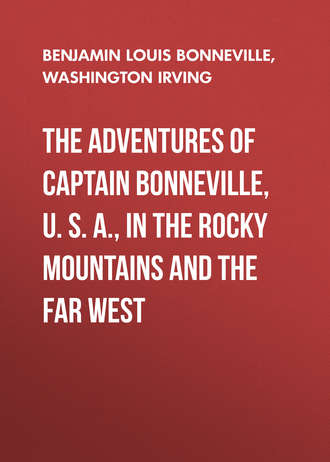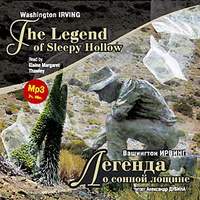 полная версия
полная версияThe Adventures of Captain Bonneville, U. S. A., in the Rocky Mountains and the Far West
The Wind River Mountains are, in fact, among the most remarkable of the whole Rocky chain; and would appear to be among the loftiest. They form, as it were, a great bed of mountains, about eighty miles in length, and from twenty to thirty in breadth; with rugged peaks, covered with eternal snows, and deep, narrow valleys full of springs, and brooks, and rock-bound lakes. From this great treasury of waters issue forth limpid streams, which, augmenting as they descend, become main tributaries of the Missouri on the one side, and the Columbia on the other; and give rise to the Seeds-ke-dee Agie, or Green River, the great Colorado of the West, that empties its current into the Gulf of California.
The Wind River Mountains are notorious in hunters’ and trappers’ stories: their rugged defiles, and the rough tracts about their neighborhood, having been lurking places for the predatory hordes of the mountains, and scenes of rough encounter with Crows and Blackfeet. It was to the west of these mountains, in the valley of the Seeds-ke-dee Agie, or Green River, that Captain Bonneville intended to make a halt for the purpose of giving repose to his people and his horses after their weary journeying; and of collecting information as to his future course. This Green River valley, and its immediate neighborhood, as we have already observed, formed the main point of rendezvous, for the present year, of the rival fur companies, and the motley populace, civilized and savage, connected with them. Several days of rugged travel, however, yet remained for the captain and his men before they should encamp in this desired resting-place.
On the 21st of July, as they were pursuing their course through one of the meadows of the Sweet Water, they beheld a horse grazing at a little distance. He showed no alarm at their approach, but suffered himself quietly to be taken, evincing a perfect state of tameness. The scouts of the party were instantly on the look-out for the owners of this animal; lest some dangerous band of savages might be lurking in the vicinity. After a narrow search, they discovered the trail of an Indian party, which had evidently passed through that neighborhood but recently. The horse was accordingly taken possession of, as an estray; but a more vigilant watch than usual was kept round the camp at nights, lest his former owners should be upon the prowl.
The travellers had now attained so high an elevation that on the 23d of July, at daybreak, there was considerable ice in the waterbuckets, and the thermometer stood at twenty-two degrees. The rarefy of the atmosphere continued to affect the wood-work of the wagons, and the wheels were incessantly falling to pieces. A remedy was at length devised. The tire of each wheel was taken off; a band of wood was nailed round the exterior of the felloes, the tire was then made red hot, replaced round the wheel, and suddenly cooled with water. By this means, the whole was bound together with great compactness.
The extreme elevation of these great steppes, which range along the feet of the Rocky Mountains, takes away from the seeming height of their peaks, which yield to few in the known world in point of altitude above the level of the sea.
On the 24th, the travellers took final leave of the Sweet Water, and keeping westwardly, over a low and very rocky ridge, one of the most southern spurs of the Wind River Mountains, they encamped, after a march of seven hours and a half, on the banks of a small clear stream, running to the south, in which they caught a number of fine trout.
The sight of these fish was hailed with pleasure, as a sign that they had reached the waters which flow into the Pacific; for it is only on the western streams of the Rocky Mountains that trout are to be taken. The stream on which they had thus encamped proved, in effect, to be tributary to the Seeds-ke-dee Agie, or Green River, into which it flowed at some distance to the south.
Captain Bonneville now considered himself as having fairly passed the crest of the Rocky Mountains; and felt some degree of exultation in being the first individual that had crossed, north of the settled provinces of Mexico, from the waters of the Atlantic to those of the Pacific, with wagons. Mr. William Sublette, the enterprising leader of the Rocky Mountain Fur Company, had, two or three years previously, reached the valley of the Wind River, which lies on the northeast of the mountains; but had proceeded with them no further.
A vast valley now spread itself before the travellers, bounded on one side by the Wind River Mountains, and to the west, by a long range of high hills. This, Captain Bonneville was assured by a veteran hunter in his company, was the great valley of the Seedske-dee; and the same informant would have fain persuaded him that a small stream, three feet deep, which he came to on the 25th, was that river. The captain was convinced, however, that the stream was too insignificant to drain so wide a valley and the adjacent mountains: he encamped, therefore, at an early hour, on its borders, that he might take the whole of the next day to reach the main river; which he presumed to flow between him and the distant range of western hills.
On the 26th of July, he commenced his march at an early hour, making directly across the valley, toward the hills in the west; proceeding at as brisk a rate as the jaded condition of his horses would permit. About eleven o’clock in the morning, a great cloud of dust was descried in the rear, advancing directly on the trail of the party. The alarm was given; they all came to a halt, and held a council of war. Some conjectured that the band of Indians, whose trail they had discovered in the neighborhood of the stray horse, had been lying in wait for them in some secret fastness of the mountains; and were about to attack them on the open plain, where they would have no shelter. Preparations were immediately made for defence; and a scouting party sent off to reconnoitre. They soon came galloping back, making signals that all was well. The cloud of dust was made by a band of fifty or sixty mounted trappers, belonging to the American Fur Company, who soon came up, leading their pack-horses. They were headed by Mr. Fontenelle, an experienced leader, or “partisan,” as a chief of a party is called in the technical language of the trappers.
Mr. Fontenelle informed Captain Bonneville that he was on his way from the company’s trading post on the Yellowstone to the yearly rendezvous, with reinforcements and supplies for their hunting and trading parties beyond the mountains; and that he expected to meet, by appointment, with a band of free trappers in that very neighborhood. He had fallen upon the trail of Captain Bonneville’s party, just after leaving the Nebraska; and, finding that they had frightened off all the game, had been obliged to push on, by forced marches, to avoid famine: both men and horses were, therefore, much travel-worn; but this was no place to halt; the plain before them he said was destitute of grass and water, neither of which would be met with short of the Green River, which was yet at a considerable distance. He hoped, he added, as his party were all on horseback, to reach the river, with hard travelling, by nightfall: but he doubted the possibility of Captain Bonneville’s arrival there with his wagons before the day following. Having imparted this information, he pushed forward with all speed.
Captain Bonneville followed on as fast as circumstances would permit. The ground was firm and gravelly; but the horses were too much fatigued to move rapidly. After a long and harassing day’s march, without pausing for a noontide meal, they were compelled, at nine o’clock at night, to encamp in an open plain, destitute of water or pasturage. On the following morning, the horses were turned loose at the peep of day; to slake their thirst, if possible, from the dew collected on the sparse grass, here and there springing up among dry sand-banks. The soil of a great part of this Green River valley is a whitish clay, into which the rain cannot penetrate, but which dries and cracks with the sun. In some places it produces a salt weed, and grass along the margins of the streams; but the wider expanses of it are desolate and barren. It was not until noon that Captain Bonneville reached the banks of the Seeds-ke-dee, or Colorado of the West; in the meantime, the sufferings of both men and horses had been excessive, and it was with almost frantic eagerness that they hurried to allay their burning thirst in the limpid current of the river.
Fontenelle and his party had not fared much better; the chief part had managed to reach the river by nightfall, but were nearly knocked up by the exertion; the horses of others sank under them, and they were obliged to pass the night upon the road.
On the following morning, July 27th, Fontenelle moved his camp across the river; while Captain Bonneville proceeded some little distance below, where there was a small but fresh meadow yielding abundant pasturage. Here the poor jaded horses were turned out to graze, and take their rest: the weary journey up the mountains had worn them down in flesh and spirit; but this last march across the thirsty plain had nearly finished them.
The captain had here the first taste of the boasted strategy of the fur trade. During his brief, but social encampment, in company with Fontenelle, that experienced trapper had managed to win over a number of Delaware Indians whom the captain had brought with him, by offering them four hundred dollars each for the ensuing autumnal hunt. The captain was somewhat astonished when he saw these hunters, on whose services he had calculated securely, suddenly pack up their traps, and go over to the rival camp. That he might in some measure, however, be even with his competitor, he dispatched two scouts to look out for the band of free trappers who were to meet Fontenelle in this neighborhood, and to endeavor to bring them to his camp.
As it would be necessary to remain some time in this neighborhood, that both men and horses might repose, and recruit their strength; and as it was a region full of danger, Captain Bonneville proceeded to fortify his camp with breastworks of logs and pickets.
These precautions were, at that time, peculiarly necessary, from the bands of Blackfeet Indians which were roving about the neighborhood. These savages are the most dangerous banditti of the mountains, and the inveterate foe of the trappers. They are Ishmaelites of the first order, always with weapon in hand, ready for action. The young braves of the tribe, who are destitute of property, go to war for booty; to gain horses, and acquire the means of setting up a lodge, supporting a family, and entitling themselves to a seat in the public councils. The veteran warriors fight merely for the love of the thing, and the consequence which success gives them among their people.
They are capital horsemen, and are generally well mounted on short, stout horses, similar to the prairie ponies to be met with at St. Louis. When on a war party, however, they go on foot, to enable them to skulk through the country with greater secrecy; to keep in thickets and ravines, and use more adroit subterfuges and stratagems. Their mode of warfare is entirely by ambush, surprise, and sudden assaults in the night time. If they succeed in causing a panic, they dash forward with headlong fury: if the enemy is on the alert, and shows no signs of fear, they become wary and deliberate in their movements.
Some of them are armed in the primitive style, with bows and arrows; the greater part have American fusees, made after the fashion of those of the Hudson’s Bay Company. These they procure at the trading post of the American Fur Company, on Marias River, where they traffic their peltries for arms, ammunition, clothing, and trinkets. They are extremely fond of spirituous liquors and tobacco; for which nuisances they are ready to exchange not merely their guns and horses, but even their wives and daughters. As they are a treacherous race, and have cherished a lurking hostility to the whites ever since one of their tribe was killed by Mr. Lewis, the associate of General Clarke, in his exploring expedition across the Rocky Mountains, the American Fur Company is obliged constantly to keep at that post a garrison of sixty or seventy men.
Under the general name of Blackfeet are comprehended several tribes: such as the Surcies, the Peagans, the Blood Indians, and the Gros Ventres of the Prairies: who roam about the southern branches of the Yellowstone and Missouri Rivers, together with some other tribes further north.
The bands infesting the Wind River Mountains and the country adjacent at the time of which we are treating, were Gros Ventres of the Prairies, which are not to be confounded with Gros Ventres of the Missouri, who keep about the lower part of that river, and are friendly to the white men.
This hostile band keeps about the headwaters of the Missouri, and numbers about nine hundred fighting men. Once in the course of two or three years they abandon their usual abodes, and make a visit to the Arapahoes of the Arkansas. Their route lies either through the Crow country, and the Black Hills, or through the lands of the Nez Perces, Flatheads, Bannacks, and Shoshonies. As they enjoy their favorite state of hostility with all these tribes, their expeditions are prone to be conducted in the most lawless and predatory style; nor do they hesitate to extend their maraudings to any party of white men they meet with; following their trails; hovering about their camps; waylaying and dogging the caravans of the free traders, and murdering the solitary trapper. The consequences are frequent and desperate fights between them and the “mountaineers,” in the wild defiles and fastnesses of the Rocky Mountains.
The band in question was, at this time, on their way homeward from one of their customary visits to the Arapahoes; and in the ensuing chapter we shall treat of some bloody encounters between them and the trappers, which had taken place just before the arrival of Captain Bonneville among the mountains.
6
Sublette and his band – Robert – Campbell – Mr. Wyeth and a band of “down-easters” – Yankee enterprise – Fitzpatrick – His adventure with the Blackfeet – A rendezvous of mountaineers – The battle of – Pierre’s Hole – An Indian ambuscade – Sublette’s return
LEAVING CAPTAIN BONNEVILLE and his band ensconced within their fortified camp in the Green River valley, we shall step back and accompany a party of the Rocky Mountain Fur Company in its progress, with supplies from St. Louis, to the annual rendezvous at Pierre’s Hole. This party consisted of sixty men, well mounted, and conducting a line of packhorses. They were commanded by Captain William Sublette, a partner in the company, and one of the most active, intrepid, and renowned leaders in this half military kind of service. He was accompanied by his associate in business, and tried companion in danger, Mr. Robert Campbell, one of the pioneers of the trade beyond the mountains, who had commanded trapping parties there in times of the greatest peril.
As these worthy compeers were on their route to the frontier, they fell in with another expedition, likewise on its way to the mountains. This was a party of regular “down-easters,” that is to say, people of New England, who, with the all-penetrating and all-pervading spirit of their race, were now pushing their way into a new field of enterprise with which they were totally unacquainted. The party had been fitted out and was maintained and commanded by Mr. Nathaniel J. Wyeth, of Boston. This gentleman had conceived an idea that a profitable fishery for salmon might be established on the Columbia River, and connected with the fur trade. He had, accordingly, invested capital in goods, calculated, as he supposed, for the Indian trade, and had enlisted a number of eastern men in his employ, who had never been in the Far West, nor knew anything of the wilderness. With these, he was bravely steering his way across the continent, undismayed by danger, difficulty, or distance, in the same way that a New England coaster and his neighbors will coolly launch forth on a voyage to the Black Sea, or a whaling cruise to the Pacific.
With all their national aptitude at expedient and resource, Wyeth and his men felt themselves completely at a loss when they reached the frontier, and found that the wilderness required experience and habitudes of which they were totally deficient. Not one of the party, excepting the leader, had ever seen an Indian or handled a rifle; they were without guide or interpreter, and totally unacquainted with “wood craft” and the modes of making their way among savage hordes, and subsisting themselves during long marches over wild mountains and barren plains.
In this predicament, Captain Sublette found them, in a manner becalmed, or rather run aground, at the little frontier town of Independence, in Missouri, and kindly took them in tow. The two parties travelled amicably together; the frontier men of Sublette’s party gave their Yankee comrades some lessons in hunting, and some insight into the art and mystery of dealing with the Indians, and they all arrived without accident at the upper branches of the Nebraska or Platte River.
In the course of their march, Mr. Fitzpatrick, the partner of the company who was resident at that time beyond the mountains, came down from the rendezvous at Pierre’s Hole to meet them and hurry them forward. He travelled in company with them until they reached the Sweet Water; then taking a couple of horses, one for the saddle, and the other as a pack-horse, he started off express for Pierre’s Hole, to make arrangements against their arrival, that he might commence his hunting campaign before the rival company.
Fitzpatrick was a hardy and experienced mountaineer, and knew all the passes and defiles. As he was pursuing his lonely course up the Green River valley, he described several horsemen at a distance, and came to a halt to reconnoitre. He supposed them to be some detachment from the rendezvous, or a party of friendly Indians. They perceived him, and setting up the war-whoop, dashed forward at full speed: he saw at once his mistake and his peril – they were Blackfeet. Springing upon his fleetest horse, and abandoning the other to the enemy, he made for the mountains, and succeeded in escaping up one of the most dangerous defiles. Here he concealed himself until he thought the Indians had gone off, when he returned into the valley. He was again pursued, lost his remaining horse, and only escaped by scrambling up among the cliffs. For several days he remained lurking among rocks and precipices, and almost famished, having but one remaining charge in his rifle, which he kept for self-defence.
In the meantime, Sublette and Campbell, with their fellow traveller, Wyeth, had pursued their march unmolested, and arrived in the Green River valley, totally unconscious that there was any lurking enemy at hand. They had encamped one night on the banks of a small stream, which came down from the Wind River Mountains, when about midnight, a band of Indians burst upon their camp, with horrible yells and whoops, and a discharge of guns and arrows. Happily no other harm was done than wounding one mule, and causing several horses to break loose from their pickets. The camp was instantly in arms; but the Indians retreated with yells of exultation, carrying off several of the horses under cover of the night.
This was somewhat of a disagreeable foretaste of mountain life to some of Wyeth’s band, accustomed only to the regular and peaceful life of New England; nor was it altogether to the taste of Captain Sublette’s men, who were chiefly creoles and townsmen from St. Louis. They continued their march the next morning, keeping scouts ahead and upon their flanks, and arrived without further molestation at Pierre’s Hole.
The first inquiry of Captain Sublette, on reaching the rendezvous, was for Fitzpatrick. He had not arrived, nor had any intelligence been received concerning him. Great uneasiness was now entertained, lest he should have fallen into the hands of the Blackfeet who had made the midnight attack upon the camp. It was a matter of general joy, therefore, when he made his appearance, conducted by two half-breed Iroquois hunters. He had lurked for several days among the mountains, until almost starved; at length he escaped the vigilance of his enemies in the night, and was so fortunate as to meet the two Iroquois hunters, who, being on horseback, conveyed him without further difficulty to the rendezvous. He arrived there so emaciated that he could scarcely be recognized.
The valley called Pierre’s Hole is about thirty miles in length and fifteen in width, bounded to the west and south by low and broken ridges, and overlooked to the east by three lofty mountains, called the three Tetons, which domineer as landmarks over a vast extent of country.
A fine stream, fed by rivulets and mountain springs, pours through the valley toward the north, dividing it into nearly equal parts. The meadows on its borders are broad and extensive, covered with willow and cotton-wood trees, so closely interlocked and matted together as to be nearly impassable.
In this valley was congregated the motley populace connected with the fur trade. Here the two rival companies had their encampments, with their retainers of all kinds: traders, trappers, hunters, and half-breeds, assembled from all quarters, awaiting their yearly supplies, and their orders to start off in new directions. Here, also, the savage tribes connected with the trade, the Nez Perces or Chopunnish Indians, and Flatheads, had pitched their lodges beside the streams, and with their squaws, awaited the distribution of goods and finery. There was, moreover, a band of fifteen free trappers, commanded by a gallant leader from Arkansas, named Sinclair, who held their encampment a little apart from the rest. Such was the wild and heterogeneous assemblage, amounting to several hundred men, civilized and savage, distributed in tents and lodges in the several camps.
The arrival of Captain Sublette with supplies put the Rocky Mountain Fur Company in full activity. The wares and merchandise were quickly opened, and as quickly disposed of to trappers and Indians; the usual excitement and revelry took place, after which all hands began to disperse to their several destinations.
On the 17th of July, a small brigade of fourteen trappers, led by Milton Sublette, brother of the captain, set out with the intention of proceeding to the southwest. They were accompanied by Sinclair and his fifteen free trappers; Wyeth, also, and his New England band of beaver hunters and salmon fishers, now dwindled down to eleven, took this opportunity to prosecute their cruise in the wilderness, accompanied with such experienced pilots. On the first day, they proceeded about eight miles to the southeast, and encamped for the night, still in the valley of Pierre’s Hole. On the following morning, just as they were raising their camp, they observed a long line of people pouring down a defile of the mountains. They at first supposed them to be Fontenelle and his party, whose arrival had been daily expected. Wyeth, however, reconnoitred them with a spy-glass, and soon perceived they were Indians. They were divided into two parties, forming, in the whole, about one hundred and fifty persons, men, women, and children. Some were on horseback, fantastically painted and arrayed, with scarlet blankets fluttering in the wind. The greater part, however, were on foot. They had perceived the trappers before they were themselves discovered, and came down yelling and whooping into the plain. On nearer approach, they were ascertained to be Blackfeet.
One of the trappers of Sublette’s brigade, a half-breed named Antoine Godin, now mounted his horse, and rode forth as if to hold a conference. He was the son of an Iroquois hunter, who had been cruelly murdered by the Blackfeet at a small stream below the mountains, which still bears his name. In company with Antoine rode forth a Flathead Indian, whose once powerful tribe had been completely broken down in their wars with the Blackfeet. Both of them, therefore, cherished the most vengeful hostility against these marauders of the mountains. The Blackfeet came to a halt. One of the chiefs advanced singly and unarmed, bearing the pipe of peace. This overture was certainly pacific; but Antoine and the Flathead were predisposed to hostility, and pretended to consider it a treacherous movement.









